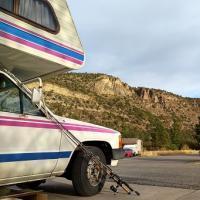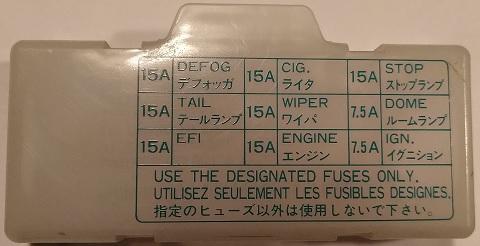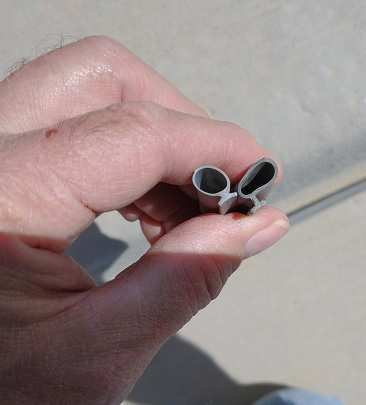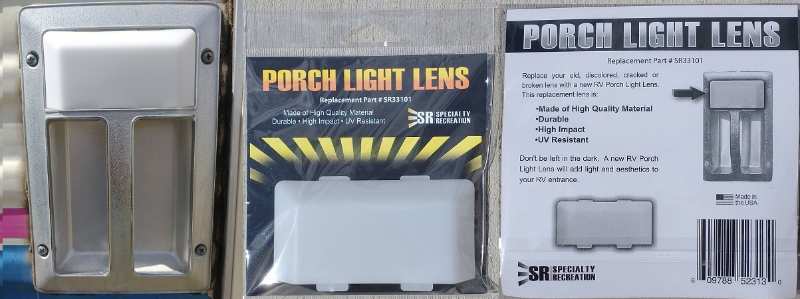-
Posts
111 -
Joined
-
Last visited
Content Type
Events
Profiles
Forums
Gallery
Everything posted by tstockma
-
Outstanding - thank you Linda, that looks just right! Ordering some now.
-
HI all, the exit hatch on my '86 New Horizons has a hollow, round seal that is mounted above the screen, pressed up again the actual plastic cover when it's tightened down. Old & disintegrated along part of the edge. I have a couple inches of a different size as a sample, but it's a tad smaller & the "mounting foot" of the new has no "riser", the old has a short "riser" molded into it. The new is approx 1/4" inside diameter, the old looks about 3/8". My RV parts store doesn't have the 3/8 size. Anyone have a good source? Amazon fails me here... And is there specific name for this style seal? Thanks for the great knowledge & help here! Tom in Strasburg
-

Can't find Porch light Lens Cover that fits..
tstockma replied to 85Seabreeze's topic in General Discussion
Is this the porch light cover you are looking for? I replaced the original on my '86 2 years ago, some reviewers (either on Amazon, or here on this site) said this brand's plastic didn't hold up, however perhaps I got a "later edition" 2 years back, I bought 2 & the first one is holding up great. If this is the porch light cover you are looking for, hie thee hence to Amazon & search for "sr33101 rv porch light lens". -
Thanks, I'll research outside of just the Amazon reviews. Recall a site or two which you'd send me towards?
-
Yikes, I sure didn't think my little question would cause this much excitement! Fred, your comment about the dc-to-dc regulator is on the money for my purposes. Linda, I will also run off my non-switched power supply from the overhead light. The only reason I'm exploring this is recent models of Maxxair fans, the 10-speed ones, apparently are more sensitive to voltage fluctuations & people report both the fans switching themselves off at times (even when not connected direct to solar), & control boards frying (yes, modern Maxxair have actual "control boards" with logic, not just old fashioned sturdier soldered switches). In my case, I've got a pretty big solar panel...the fan is very efficient, 5 amp on high...I'll usually run at slower speeds, like that 1 amp low setting...I'm not worried about drawing too much power. I'm just wanting to protect what apparently is a somewhat delicate but otherwise very well reviewed roof vent fan. That said, I don't want to interfere with a spirited technical brouhaha, so don't let me stop the discussion.... ; )
-
Thanks all - I'll check that Analog device & caps. I'm looking into this because I've seen some new Maxxair fans get review on Amazon stating they're pretty picky about getting too much current & cut out if they detect that (or even fry out because they're sensitive). I'll put a meter on mine - I plan to wire through the ceiling light next to the old non-powered 14x4 vent - and see if the solar is regulated well enough by the controller, that I don't need to worry about this.
-
Nice looking rig! Welcome to the forums & the community of owners. For immediate attention, be sure you check engine oil carefully for the first several hours - especially first time you're on the highway for more than 30 minutes. If the previous owners did something like start the rig up every few months (or years) to keep battery & engine from going stale (& this is very common), enough condensation occurs in that engine to artificially raise the oil level. So new owner drives across town or even an hour or two, but not at real high temps - the oil level seems fine because it's not been heated for long enough - then first time at real speeds, the water evaporates out of the oil & the new owner panics when oil light comes on & they discover very low oil levels. (The engines are tough, adding oil when it's first discovered means all is well, except the new owner is now panicked that they've damaged the engine & there's a frightful Mystery Of The Disapparing Oil to be solved.) Air up - I go with the 40 front, 45 rear - look for threads on changing tranny fluid WITHOUT dropping the pan, instead 2 or 3 changes where you empty thru the drain hole at appropriate intervals, to avoid precipitous flushing of crud which too often happens when well-intentioned mechanics insist on a full pan-drop-and-flush treatment results in blown transmission. Be sure to air up the air bags (assuming you have them) before you drive each time, monitor every couple of hours at first, to find out if they hold air (mine don't & are being replaced next month). Also I'd recommend this, for short-term helpful info & long-term project list: Welcome & good look! Tom
-
I plan to install one of the better Maxxair fans, I see many reviews say if voltage goes over something like 13.6, they automatically shut down. And solar systems often go over that. Anyone know of a cheap reliable way to do that? Amazon shows me power filters, step-downs, all kinds of options, & don't tend to be cheap. I just need something small & inexpensive to keep voltage within a normal 12 volt system's range.
-
Consider lower tire pressure - I run 40 front, 45 rear & am OK with somewhat lesser mileage. At 5 lbs more front & rear, I start to feel every crack in the pavement.
-
Oh yeah baby! My dad might never have changed tranny fluid on any car before he got this Toyota rig, but did his research - he concluded at 45K dropping the pan was safe to do, so paid for a proper change - then at 91K last summer, while I could have dropped the pan, instead I did the proper method for unknown history or very old rigs. Pull tranny fluid out the drain hole & top it up, drive gently for 100 miles (be sure to work each gear shift position), repeat, drive another 500-1000 miles & repeat. Done. Immediate improvement in shifting. When weather turns warm again, having learned from posts here, I plan to check that output shaft for any play or other signs of issues - that's the one weakness people talk about, on these overworked reliable old A43's. I only recently saw apparently you can insert a sleeve over a shaft that's been scored, rather than more serious surgery, if a new seal doesn't stop any leaks. Maineah, I really value your knowledge & experience, & Linda, & others like you. Keeps me coming back. (Still miss Derek too.)
-
Yep - A43, in an '86 21 foot New Horizon, 22RE engine. Looks like between my dad who had first & me, we've done two fluid changes at 40-45k mile intervals, and it's possible the original owner did one before dad got it at around 45k. ...I speculate you may have something internal beginning to go, but it might last a long time before it need fixin'.
-
An important part of our community, and an example & reminder to me to stay engaged. Thank you Derek for your life well lived.
-
Jamblin, I'm more aligned with your thinking, that sounds odd to me. I don't think it should be shifting into 3rd. I have similar situations driving the Rockies here in Colorado, Denver area, where yep I'll leave it in 2nd but give it a touch of gas when the grade lessens, I haven't encountered what you have. Since you've changed the fluid, possibly needs someone knowledgeable to check shift linkage - but seems unlikely since otherwise I believe you'd see no difference at all when you use it, clearly that's not the case. So I'd think something is going awry & I'd probably pay someone to look at it. Or check with https://www.yotatech.com/forums/f116/ these guys if you're 2nd or 3rd generation truck, or find the right forum for other... "Foot off the gas" changes vacuum & that's part of controlling shifting. I'd suspect weakness in something related. WME of course might be right & it's normal, seems like the more I learn, the more gaps in my knowledge get uncovered...
-
The "Cubic Mini" woodstove for RVs A neighbor of mine rebuilt on old RV entirely from just the frame, put in an elegant little wood stove that takes wood no longer than 5" long, called the "Cubic Mini" for cabins, RVs, & boats no longer than 40 feet. Says it works like a champ. Just under one foot in all dimensions, mounts on the wall with a nice heat shield, good stovepipe & small chimney sticking out on top. I always thought wood stoves in our little Toyo rigs was not workable, 'till I saw these. Pretty much a cube, no dimension larger than 1 foot. These pics don't show the heat shield well, it runs all the way to the ceiling.
-
There's also a fusebox in the engine compartment, on my '86 it is amazingly poorly labelled & documented. I can't recall which lights went out that caused me to go looking (might've been a left headlight) - but a very generically labelled fuse slot under the hood was the culprit. The year or at least generation of your truck will help the experts here narrow that search down.. Good luck!
-
I've been in it for several months, like it just fine. With the distancing, no get-togethers, but I'm in both the Toyota & the Colorado groups, probably I'll set up a meet up of some kind here in Colorado's Rockies come summer. I'm 2-3 years away from retirement, as I'm looking into various RV clubs & orgs, I think I'm seeing some real value in it. If/when I do set up the Colorado event, I'll likely post here too.
-
Find the New Owners Checklist, it is loaded with great info. I read extensively on people's experience here in the forums, and for safest ride & handling, I run 40 in the fronts, 45 in the rears on my '86 New Horizon (coach similar in size to your Dolphin). I've owned a few pretty odd cars & some of them are fatally dangerous if I were to use "max possible pressure as listed on the tire" - there's many differences of opinion here in the forums but those numbers I use seem to come from knowledgeable sources & I like how my rig handles on our twisty & steep Colorado mountain roads. Running higher pressures (I wouldn't go over Ed's 55 psi) is not bad, but as Linda noted, I'd keep the fronts 5 pounds under the rear - on any car with significantly more weight in the rear, less pressure up front is a significant handling & safety feature. You'll notice you feel every crack in that highway & the rattling inside the rig will climb from constant to truly amazing levels. Enjoy!
-

Thinking about Buying a Chinook! What to be weary of?
tstockma replied to cmuns's topic in General Discussion
Welcome to the Denver ownership club - I also do most of my own servicing. You've probably found the "new owner checklist", I do highly recommend it - I haven't followed it right down the line, too much to fix all at once! So I prioritized tasks & will probably have most of the items done in another couple years. ...if your tires are 10 years old, replace replace replace. -
Hey I'm also in Denver area & have an '86 with the 22RE engine - here's a very useful tip for you (sorry, I'll tell a story to illustrate the point). Got the RV from my old man & he licensed it in South Dakota where no emissions tests exist - so he removed the Catalytic converter. When we bought it from him, we had just borrowed the rig for a several hundred mile trip to Ridgway (in Montrose), over Monarch & several other passes, so we'd driven it at max RPMs crawling over those mountains. When I took it to the emissions station a few weeks later, not realizing there's no cat, we got a peculiar result that left the inspectors scratching their heads. "We don't understand it, but your numbers are just fine. However you fail the test because we have to visually inspect the catalytic converter, and you don't have one." So here's my advice - and I've done this with various old cars in Denver over the decades: after you do some steps above, especially tuneup related, and you have that carb adjusted, and that timing reset is critical - run your rig up to Evergreen & back on I-70. Depending on your transmission, you should find what speeds in what gear cause close to max RPMs - there are others here who know what that is. In my '86 22RE with 3-speed transmission (don't use overdrive), I go with about 28 MPH in 1st, 55 in 2nd. This will burn out & clean up those cylinders & valves & plugs amazingly well. (Make sure your hoses are OK before you do - this will test any weak spots in the cooling system & maybe other systems in the mechanics.) Then even if you retest a few days later, drive on the freeway for 20 minutes, so you hit the emissions station with the engine hot, and during a quiet time when you won't shut it off sitting in line for more than 20 or 30 minutes - this makes a big difference on older vehicles. Luck! Oh yeah, the rest of my story - Diane & I own a house on some land in the country, south of Strasburg - we plan to move there next summer from Parker, once the current renter's lease is up - so I register & license the rig out there. It's far enough out in the agricultural country that emissions aren't yet required. Eureka! ...city's growing that way, I expect I'll add a cat in the next few years.
-
Yes - good man there. Would like to hear how he's doing. Thoughts & prayers here.
-
New question on this old topic... Background: Derek was absolutely right here, I received 3T's air springs replacement kit, and it's just dressed-up Firestones. I haven't put them in yet, but looks like 3T put fittings on the Firestone parts so they'll play well with the 34 year old 3T setup on my 1986 New Horizon...and they included new air lines & fittings, so the only part they didn't include & don't have anymore, is the metal bracket. New question: I'd like to add an on-board air pump to this system, & have it on hand before I disassemble the old setup. (Why do parts of the job twice?) Anyone have recommendations on brand or models?







